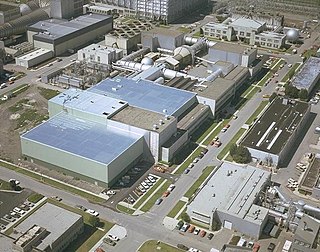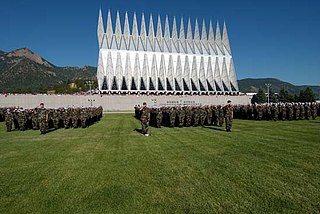
The Ames Research Center (ARC), also known as NASA Ames, is a major NASA research center at Moffett Federal Airfield in California's Silicon Valley. It was founded in 1939 as the second National Advisory Committee for Aeronautics (NACA) laboratory. That agency was dissolved and its assets and personnel transferred to the newly created National Aeronautics and Space Administration (NASA) on October 1, 1958. NASA Ames is named in honor of Joseph Sweetman Ames, a physicist and one of the founding members of NACA. At last estimate NASA Ames had over US$3 billion in capital equipment, 2,300 research personnel and a US$860 million annual budget.

The Goldstone Deep Space Communications Complex (GDSCC), commonly called the Goldstone Observatory, is a satellite ground station located in Fort Irwin in the U.S. state of California. Operated by NASA's Jet Propulsion Laboratory (JPL), its main purpose is to track and communicate with interplanetary space missions. It is named after Goldstone, California, a nearby gold-mining ghost town.

The George Herbert Jones Laboratory is an academic building at 5747 S. Ellis Avenue, Chicago, Illinois, on the main campus of the University of Chicago. Room 405 of the building was named a National Historic Landmark in 1967; it was the site where plutonium, the first man-made element, was isolated and measured.

The McKinley Climatic Laboratory is both an active laboratory and a historic site located in Building 440 on Eglin Air Force Base, Florida. The laboratory is part of the 96th Test Wing. In addition to Air Force testing, it can be used by other US government agencies and private industry.

The Neil Armstrong Operations and Checkout Building (O&C) is a historic building on Merritt Island, Florida, United States. The five-story structure is in the Industrial Area of NASA's Kennedy Space Center. Its has twin-block facilities that include the crew quarter dormitories for astronauts, suit-up preparations prior to their flights, and the other is a large spacecraft workshop used for manufacturing and checking activities on crewed spacecraft. On January 21, 2000, it was added to the U.S. National Register of Historic Places.

Rocket Engine Test Facility was the name of a facility at the NASA Glenn Research Center, formerly known as the Lewis Research Center, in Ohio. The purpose of the Rocket Engine Test Facility was to test full-scale liquid hydrogen rockets at thrust chamber pressures of up to 2100 psia and thrust levels to at least 20,000 pounds. Work on the design of the facility began in 1954 under the auspices of NACA's Rocket Branch of the Fuels and Combustion Research Division. It was built at a cost of $2.5 million and completed in 1957. The facility was located at the south end of the Center, adjacent to Abrams Creek 41.404°N 81.868°W. It was demolished in 2003 in order to make way for the runway expansion of the Cleveland Hopkins International Airport.

The Unitary Plan Wind Tunnel, located at the NASA Ames Research Center in Moffett Federal Airfield, Mountain View, California, United States, is a research facility used extensively to design and test new generations of aircraft, both commercial and military, as well as NASA space vehicles, including the Space Shuttle. The facility was completed in 1955 and is one of five facilities created after the 1949 Unitary Plan Act supporting aeronautics research.

The Neutral Buoyancy Simulator was a neutral buoyancy pool located at NASA's George C. Marshall Space Flight Center (MSFC). Engineers and astronauts developed hardware and practiced procedures in this tank from its completion in 1968 through its decommissioning in 1997. Marshall recognized the need for underwater simulations of extra-vehicular activities (EVAs) and developed three successively larger tanks for the purpose. The Neutral Buoyancy Simulator contributed significantly to the American crewed space program. Skylab, the Space Shuttle, Hubble Space Telescope, and the International Space Station have all benefited from the Neutral Buoyancy Simulator. Until Johnson Space Center constructed the Weightless Environment Test Facility in the mid-1970s, MSFC had the only NASA-owned test facility that allowed engineers and astronauts to become familiar with the dynamics of body motion under weightless conditions.

The Lunar Landing Research Facility was an area at NASA's Langley Research Center in Hampton, Virginia that was used to simulate Apollo Moon landings with a mock Lunar Module powered by a small rocket motor suspended from a crane over a simulated lunar landscape.

Saturn V dynamic test stand, also known as dynamic structural test facility, at the George C. Marshall Space Flight Center in Huntsville, Alabama is the test stand used for testing of the Saturn V rocket and the Space Shuttle prior to the vehicles' first flights. Designated building 4550, it stands 363 feet (111 m) tall and is 98 feet (30 m) square. Its central bay has maximum dimensions of 74 by 74 feet, and it is topped by a derrick capable of moving 200-ton objects in a 70-foot (21 m) radius. An elevator provides access to 15 levels in the structure, and a cable tunnel connects the building to control facilities in the space center's East Test Area.

The Space Flight Operations Facility (SFOF) is a building containing a control room and related computing and communications equipment areas at the Jet Propulsion Laboratory in Pasadena, California. NASA's Deep Space Network is operated from this facility. The SFOF has monitored and controlled all interplanetary and deep space exploration for NASA and other international space agencies since 1963. The facility also acted as a backup communications facility for Apollo missions.

The Spacecraft Propulsion Research Facility, now known as the In-Space Propulsion Facility, is, the "world’s only facility capable of testing full-scale upper-stage launch vehicles and rocket engines under simulated high-altitude conditions." The facility, located at NASA's Plum Brook Station of the Glenn Research Center near Sandusky, Ohio, was built in 1968. Its first major use was for testing stages of the Centaur Rocket, which was used to launch some of America's most important space probes. The facility was designated a National Historic Landmark in 1985.

The Rendezvous Docking Simulator, also known as the Real-Time Dynamic Simulator, is a simulator at the Langley Research Center. It was constructed for the Gemini program in Building 1244 and it became operational in June 1963 at a cost of $320,000 and later reconfigured for the Apollo program. The simulator consists of a gantry frame, with an overhead carriage from which test craft were suspended by cables. A gimbal was powered hydraulically and was capable of changing pitch and yaw at a rate of 1 radian per second or roll at 2 radians per second. The gantry also moved like an overhead crane using electric motors and was capable of travelling 210 feet (64 m) longitudinally at up to 20 feet per second (6.1 m/s), 16 feet (4.9 m) laterally at up to 4 feet per second (1.2 m/s) and vertically 45 feet (14 m) at up to 10 feet per second (3.0 m/s).

The Spacecraft Magnetic Test Facility, also known historically as the Attitude Control Test Facility, is an experimental spacecraft test facility at the Goddard Space Flight Center in Greenbelt, Maryland, United States. It was built in 1966 to allow the evaluation of magnetic movement in crewed and uncrewed spacecraft, and for the precision calibration of magnetometers used in space flight. The building is constructed of non-magnetic materials and contains a magnetic coil system that allows the cancellation of the Earth's magnetic field. This unique building was designated a National Historic Landmark in 1985.

The Zero Gravity Research Facility at the NASA Glenn Research Center in Cleveland, Ohio is a unique facility designed to perform tests in a reduced gravity environment. It has successfully supported research for the United States crewed spacecraft programs and numerous uncrewed projects. The facility uses vertical drop tests in a vacuum chamber to investigate the behavior of components, systems, liquids, gases, and combustion in such circumstances.

The Space Environment Simulation Laboratory (SESL) is a facility in Building 32 at the Lyndon B. Johnson Space Center that can perform large-scale simulations of the vacuum and thermal environments that would be encountered in space. Built in 1965, it was initially used to test Apollo Program spacecraft and equipment in a space environment, and continues to be used by NASA for testing equipment. It was designated a National Historic Landmark in 1985.

The United States Air Force Academy, Cadet Area is a portion of the United States Air Force Academy near Colorado Springs, Colorado. Its use of modern architecture stands in contrast with the very traditional designs of West Point and the United States Naval Academy. It was designated a National Historic Landmark District in 2004 for its landscape, architecture, and historic importance as a military academy.

This is a list of the National Register of Historic Places listings in Pasadena, California.

The Paradise Historic District comprises the historic portion of Paradise developed area of Mount Rainier National Park. The subalpine district surrounds its primary structure, the Paradise Inn, a rustic-style hotel built in 1917 to accommodate visitors to the park. The Paradise Inn is a National Historic Landmark. Five other buildings are included in the district. The district was placed on the National Register of Historic Places on March 13, 1991. It is part of the Mount Rainier National Historic Landmark District, which encompasses the entire park and which recognizes the park's inventory of Park Service-designed rustic architecture.























